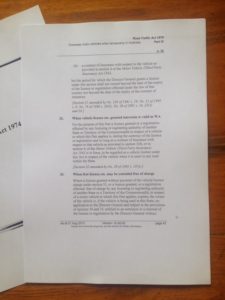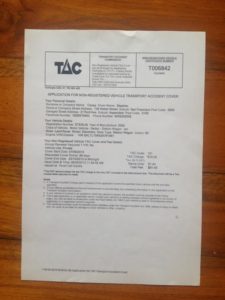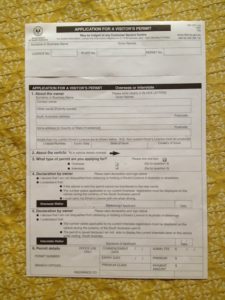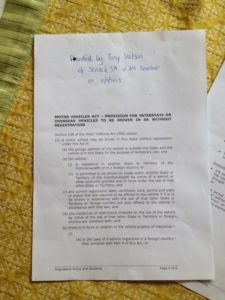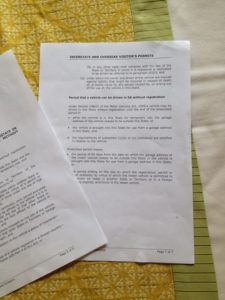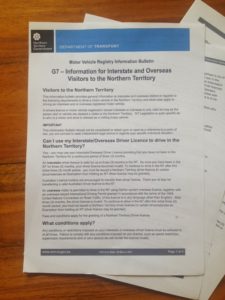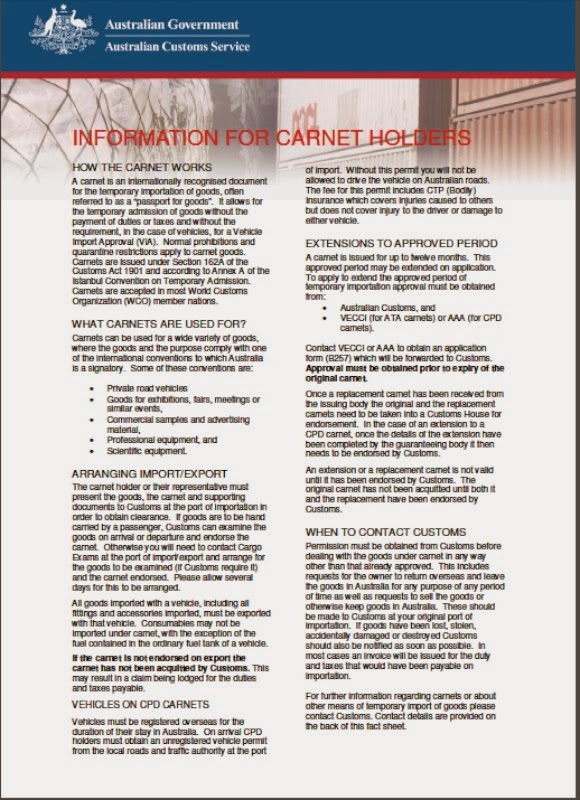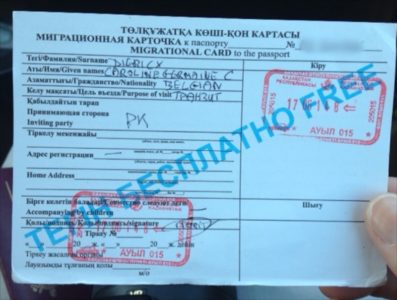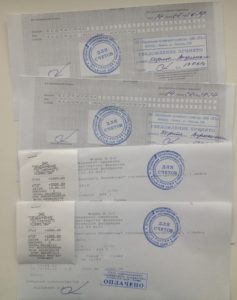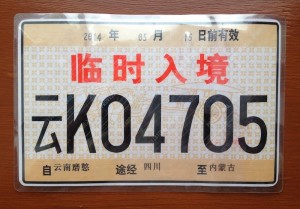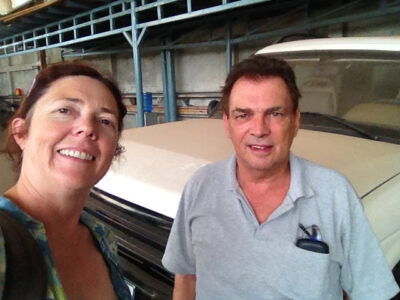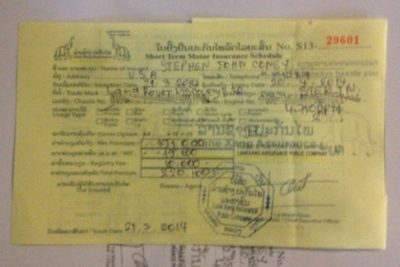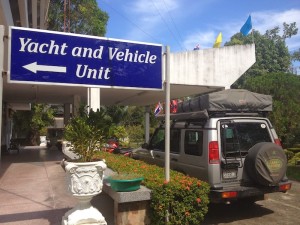This post is about the government documentation we needed and obtained to bring our car into Australia.
Australia in General
Our car arrived by container ship into Port Botany, Sydney from Los Angeles. We were not involved in any of the customs, quarantine or clearance process as our local shipping agent handling all these matters and managed the process completely. Our local shipping agent was Freightnet International and Maria was our very excellent contact there. Freightnet did a good job and based on our experience with them we are very happy to recommend their services to others. The whole process, from when the ship arrived at the port to driving the car away from the warehouse, took only 5 days.
Australia has a reputation as being a difficult country to import cars into. The commonly mentioned challenges are:-
- Bio-security. Australians do not like bugs and other little creatures entering their country.
- Oil-leaks. Local road authorities do not want the engine to be leaking oil.
- Air Conditioning refrigerant. Older air conditioning units use refrigerant that is not ozone friendly and these are not permitted to be imported into Australia without a special permit.
- Vehicle Import Approval. To ensure that the vehicle achieves certain design and safety standards, a Vehicle Import Approval is required before permanently shipping a car to Australia.
Australia is infamous for their bio-security and quarantine procedures and for ensuring no bugs enter the country. So before we sent the car from the United States, we gave it a really good clean. And I mean a really good clean, including removing all bugs from the radiator and dashboard and de-greasing the engine. As it turned out, we had no bio-security issues with our car entering Australia and the authorities did not make us pay for any additional cleaning. Maybe we were lucky.
Typically cars that are permanently imported into Australia need the air conditioning unit degassed to ensure that no ozone depleting gas is present. This is not required for cars being temporarily imported under a Carnet de Passage. Prior to leaving the United States we contacted the Department of Sustainability, Environment, Water, Population and Communities at ozone@environment.gov.au to ensure we did not need to drain refrigerant in either the car’s air conditioning unit or in our portable fridge/freezer. Both pieces of equipment use the ozone friendly R134a refrigerant. I got a friendly email back which included a little bit of legal language, but the bottom-line is that no ODS/SGG equipment licence is required assuming a temporary import and all other custom matters are in order.
Our shipping agent in the United States was under the mistaken belief that we required a Vehicle Import Approval (VIA) and were not going to ship the car until we had obtained this permit. It took a little convincing, but they did agree to ship without the VIA permit, which of course is not needed. The Australian Customs services publishes a fact-sheet covering this which is available here and is attached below.
We had packed some personal items in our car. These were also cleared by Australian Customs at the same time as the car. We completed an “Unaccompanied Personal Effects Statement” for the personal items and attached an inventory.
Apart from the above, each state in Australia has their own road and transport authorities and therefore their own requirements associated third party insurance and vehicle standards. The Australian Automobile Associated has information for Carnet holders on their website. Unfortunately most of it does not seem to be correct, or at least the information for each State is only relevant if the vehicle is being off-loaded from a ship in that particular state. There are all sort of other options if the vehicle was off-loaded in a different state and is travelling interstate. It is however a good place to start for your research. The AAA information can be found here.
We carried copies of our US vehicle documentation, the Carnet de Passage, the Victorian Permit and copies of information sheets and various extracts from state law. Just in case we got pulled over by the Police. But as it turned out, we never got stopped. More details of each state we visited is available below.
New South Wales
As our car arrived in Sydney, we were subject to the regulations of the New South Wales government and the Roads and Maritime Services of the Transport department.
The very good news is that there is no paperwork required for the State of New South Wales. This is all explained on their website here. An extract from the government website regarding Visiting Overseas Vehicles is provided below:
Visiting overseas vehicles may be used temporarily in NSW without being registered in NSW, if the vehicle is registered in its home jurisdiction and displays any required number plates and labels. It is also recommended that the overseas registration certificate be carried when using the vehicle. These vehicles are exempt from NSW registration and Compulsory Third Party insurance. A NSW third party personal injury claim involving a visiting overseas vehicle is made against the Nominal Defendant Scheme. This scheme is administered by the Motor Accidents Authority. For information about NSW vehicle standards for visiting overseas vehicles please contact Technical Enquiries. For information about importing visiting overseas vehicles please contact the Commonwealth Department of Infrastructure and Transport.
Based on this information we did not even bother contacting the Road Traffic Authority and assumed we were ok.
Victoria
As we were heading south we would be crossing into the State of Victoria. Unlike New South Wales, this State requires a permit to drive an overseas registered vehicle. The permit is issued by the Transport Accident Commission via a VicRoads service center. Several hours were spent on the phone with VicRoads, and in the end a Non-Registered Vehicle Certificate was issued.
There are four requirements to obtain this permit:
- Provide a copy of the Carnet de Passages and voucher stamped by the Australian Customs and Border Protection Service.
- Provide a copy of the Vehicle Registration showing that the vehicle is registered in California, USA.
- Provide an address where the car is garaged while in the State of Victoria.
- Payment of a fee for the third party insurance.
As you can see, one of the requirements to obtain this permit is to provide an address where the vehicle will be garaged while in Victoria. In our case, we were planning to travel around and this did not seem to make too much sense. But the address is needed to calculate the insurance premium, so we ended up just giving the address of our friends. The cost of a 48-day certificate was AUD$81.40. We purchased our permit before we crossed into Victoria and it was faxed to us so we could carry it as proof of insurance.
South Australia
The South Australian Government website provides information on obtaining an International Visitors Permit which can be found here. The website is pretty clear that “Visitors travelling in a vehicle that is registered overseas need to apply for an international visitor’s permit to drive the vehicle in South Australia”. The permit is actually third party insurance for the period the vehicle is in the State of South Australia.
We rang Service SA who administer car registrations for South Australia and they advised that an International Visitors Permit can only be obtained at a Service SA center. That is, it is not possible to obtain one over the phone. So as soon as we entered South Australia we immediately visited the appropriate government office. Our request for an international visitor’s permit was a little unusual and it took a while for the staff to find the right form for us. After filling out the form, providing the Carnet de Passage paperwork, our California registration, third party insurance issued by the State of Victoria and after the government staff consulting their various handbooks and state law it was determined that we did not in-fact need a permit and the Victorian issued permit/insurance was sufficient. The government office staff gave us a copy of the applicable act which is summarized below. We carried a copy of this act in case we were stopped by the police. We were very impressed with the Service SA staff and especially impressed with how friendly and keen they were to help.
Section 19A of the Motor Vehicles Act 1959, states:
(1) A motor vehicle maybe driven in this State without registration under this Act if:
(a) the garage address of the vehicle is outside this State and the vehicle is in this State for the purposes of temporary use; and
(b) the vehicle:
(i) is registered in another State or Territory of the Commonwealth or in a foreign country; or
(ii) is permitted to be driven on roads within another State or Territory of the Commonwealth by virtue of a permit or authority granted and in force under the law of that other State or Territory; and
(c) any current registration label, certificate, card, permit and plate or plates that are required to be affixed to the vehicle if it is to be driven in accordance with the law of that other State or Territory or foreign country are duly affixed to the vehicle in accordance with that law; and
The Act goes on to talk about other conditions, period that the vehicle can be driven in South Australia without registration and various insurance matters. Clearly the public website is incorrect and although we spent 45 minutes in the government office sorting this out, we were pleased to leave without having to pay for additional insurance. South Australian law and the Motor Vehicles Act 1959 is available on-line via a simple search.
Northern Territory
Northern Territory publish a fact sheet titled “G7 – Information for Interstate and Overseas Visitors to the Northern Territory”. At the time of writing this document can be found here. In this document it is pretty clear that we do not need additional documentation or insurance for the Northern Territory assuming we have a permit from another state. The key part of the document is provided below:
Yes – you may drive your overseas registered motor vehicle in the NT, providing that the vehicle is deemed a “visiting motor vehicle”. A “visiting motor vehicle” means a motor vehicle under Section 3 of the NT Traffic Act, but the following conditions apply
• the vehicle must be, and remain, registered in another country for the duration of its stay in the NT; and
• have affixed a current registration label, and number plates required to be affixed by the law of that country; and
• is temporarily in the Northern Territory; and
• there is in force a policy of insurance issued within Australia, complying with the provisions of a law in force in a State or Territory of the Commonwealth requiring the owner or driver of a motor vehicle to be insured against liability in respect of the death of, or bodily injury to, a person caused by, or arising out of, the use of the motor vehicle; and
• If the vehicle first entered Australia in the NT, it must be inspected at a NT Government Inspection Test Shed for compliance with NT roadworthy requirements, fee’s apply; and
• The owner of the vehicle must supply a copy of the CARNET associated with the importation of that vehicle.
Based on this information we did not even bother contacting the Department of Lands and Planning, Motor Vehicle Registry and assumed we were ok.
Western Australia
The Western Australian Department of Transport website provides information on obtaining an Overseas Visitors Vehicle Licence (link). However this information is a bit misleading, as it assumes you have landed the vehicle in Western Australia. According to the Western Australia Road Act of 1974, you are granted an Overseas Visitor Vehicle License if you already have a license from another Australian state. The actual text from the act is
For the purpose of this Part a licence granted or a registration effected by any licensing or registering authority of another State or Territory of the Commonwealth in respect of a vehicle to which this Part applies is, during the currency of the licence or registration and so long as a contract of insurance with respect to that vehicle as provided in section 3(4), or in section 4, of the Motor Vehicle (Third Party Insurance) Act 1943 is in force, to be regarded as a vehicle licence under this Act in respect of the vehicle when it is used on any road within the State.
Our reading of the above is that the paperwork we obtained in Victoria along with the third party insurance we hold is our licence and is sufficient for Western Australia. The Western Australian Department of Transport website also states that the “Headlights on left-hand drive vehicles must be modified to dip to the left.”. We did not do this and we can find nothing in the applicable law that actually states that this is required. I have also read that a “Left Hand Drive Vehicle” sign needs to be attached to the rear of the vehicle and such signs can be obtained from the RAC of WA. Again the law does not require this and the RAC of WA does not sell these signs.
Tasmania, Queensland and ACT
We did not travel to these areas, so sorry, no information to share.


